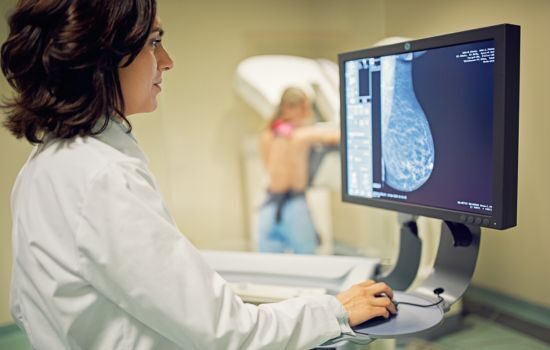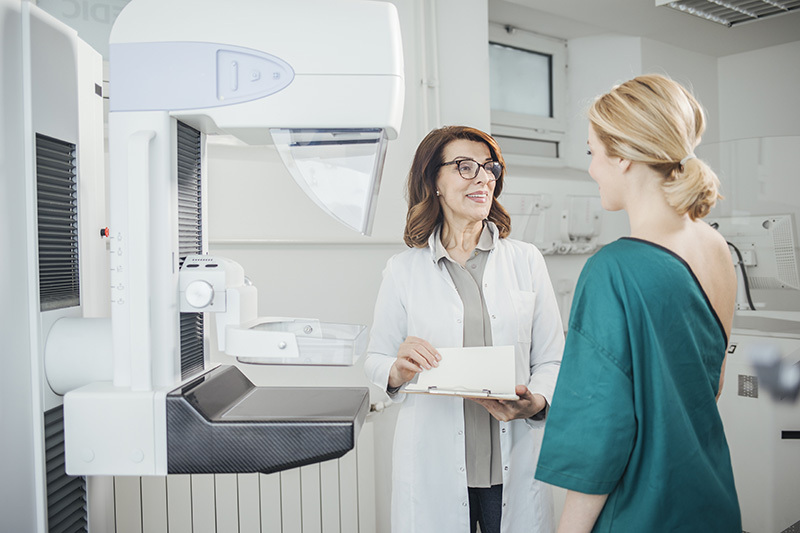Attention GCI Patients — Effective October 6, 2025, the GCI Oak Lawn location will be closed. All patients of GCI Oak Lawn will be seen at our Chicago Ridge location at 10604 Southwest Highway, Suite 109, Chicago Ridge, IL 60415.
November 6, 2023
Abnormal Mammogram? Here’s What’s Next.

Getting a mammogram regularly, based on your level of breast cancer risk, helps detect breast cancer early when treatment is easier. About 10% of all mammograms show something that’s abnormal and needs to be looked at further to determine if cancer is present. If this happens to you, it’s helpful to know what may happen next.
Diagnostic Imaging Following an Abnormal Mammogram
After your mammogram is complete, a radiologist will review the images to check for anything abnormal. If you have had more than one mammogram at the same facility they are likely to compare your current images to those you’ve had in the past to look for anything that may have changed.

If the radiologist finds something of concern they will communicate with your doctor who will contact you with next steps.
Most of the time there are more images needed of your breast to get a more detailed look. This can be done in one or more ways:
Diagnostic mammogram. A diagnostic mammogram uses the same machine but there may be more images taken. Re-taking the mammogram can confirm if something seen on the first mammogram was just a shadow or fold in the tissue versus a lump that needs to be biopsied.
Ultrasound. An ultrasound is another imaging test that can be used to see if a lump in the breast is a solid tumor or a liquid-filled cyst. Ultrasound tests involve laying flat on a table while an ultrasound technologist uses a small device to scan the breast. The ultrasound will allow your doctor to get better images of the breast with abnormal results.
Breast MRI. MRIs are also sometimes used to provide additional diagnostic information following an abnormal screening mammogram. MRIs use radio waves and magnets to capture more detailed images of the inside of the breast.
A Breast BI-RADS Score is Determined
The images taken of the breast will be given a BI-RADS score (Breast Imaging Reporting and Data System). This score ranges from 0 to 6, and it helps to categorize the results.
A score of 0 means that the images were not clear enough and that additional testing is needed.
A score of 1 means no sign of cancer.
If the score is 2 or 3, something was noticed, but it likely is not cancer and will need to be monitored.
A score of 4 or 5 indicates that there is a lump that could be cancerous and a breast biopsy is recommended to confirm.
A score of 6 means that cancer has been confirmed with a biopsy.
What Happens if Breast Cancer is Suspected on Diagnostic Imaging Tests?
If diagnostic test results point to a likelihood of breast cancer being present your doctor will suggest a biopsy as this is the sole way to confirm a diagnosis.
Breast Biopsy to Determine if Cancer is Present
As mentioned, a breast biopsy helps confirm a cancer diagnosis. This procedure involves a small tissue sample from the breast being taken using a long needle. Sometimes, the area of insertion will be numbed to make the procedure more comfortable. This procedure will usually take around 60 to 90 minutes. Imaging scans are often used to guide the process to be sure tissue is removed from the exact area where cancer is suspected.
Breast Biopsy Pathology Report
After the biopsy is complete, the sample will be sent to a pathology lab for analysis. There, a doctor who specializes in the analysis of tissue, called a pathologist, will review the sample under a microscope to confirm whether or not cancer cells are present. If it is determined that there are cancer cells in the sample, other cell characteristics will be looked at to help pinpoint the exact type of breast cancer. This will guide the cancer specialist when planning the best treatment approach. The report will then be sent to your doctor, who will talk with you about the results.
What Happens if the Pathology Report Shows Breast Cancer?
If the pathology report comes back and a breast cancer diagnosis has been confirmed, then you will begin seeing an oncologist. This is someone who specializes in the treatment of cancer. There are a few types of oncologists. A medical oncologist will typically lead the breast cancer care team, working with the surgeon, radiation oncologist and other healthcare professionals who will be included in your treatment plan.
Your first visit with the oncologist will most likely include a discussion of what they know from the biopsy and images as well as from other tests run to determine if the cancer is hormone positive and/or HER2 positive. There may also need to be additional images and possibly a lymph node biopsy to determine if the cancer has spread.
Find out how to plan for your first visit with a breast cancer specialist.
Treatment Planning for Breast Cancer
Since there are many different forms of breast cancer, treatment approaches will vary from person to person. Different types of cancer respond better to specific treatment approaches. Your overall health and age will also be taken into consideration when determining the best treatment approach. Your oncologist will also consider the size of the tumor, staging, hormone receptor status and lymph node involvement.
Common treatment approaches for breast cancer include:
Surgery. Surgical removal of the tumor in the breast is almost always part of the breast cancer treatment process. When found early a lumpectomy, or breast conserving surgery, is usually all that is needed followed by radiation therapy to that area of the breast.After meeting with the oncologist and the breast surgeon a recommendation will be made for you.
Radiation therapy. Radiation therapy uses high-energy beams to kill cancerous cells. It is common for doctors to recommend radiation therapy for breast cancer in combination with surgery. Your doctor may have you do breast radiation before surgery or after. Learn more about radiation therapy for breast cancer.
Chemotherapy. Chemotherapy works to treat cancer by killing cancer cells. There are many different types of chemotherapy drugs that work well for different types of breast cancer.
Targeted therapy. Targeted therapy uses drugs that specifically attack certain proteins in the breast cancer cells. These drugs specifically target the proteins such as HER2 that help the cancer cells grow and spread. Targeted therapy drugs are only used for specific types of breast cancer, and the side effects will be different when compared with chemotherapy.
Hormone therapy. Some forms of breast cancer have hormone receptors, which means that certain hormones feed the cancer’s growth, like estrogen and progesterone. For that reason, hormone therapy can be used for these cancers by working to block the production of the hormones to slow the cancer growth.
Immunotherapy. Immunotherapy works by stimulating your body’s own immune system to attack the cancer cells. Immunotherapy may be recommended in treating breast cancer that has come back locally or for triple-negative breast cancer. It can also be used when surgery is not an option or for cancer that has spread to other parts of the body (metastasized).
Deciding on the best breast cancer treatment approach for you will depend on many factors. Your oncologist will review all of your test results and determine your treatment plan based on your type of cancer, the breast cancer stage, your overall health, your preferences, and more.

Breast Cancer Specialists in the South Chicago Suburbs
If you or someone close to you was recently diagnosed with breast cancer, the breast cancer specialists at Affiliated Oncologists will work closely with you to determine a personalized treatment approach for your diagnosis. Our cancer centers are located in Chicago Ridge, Mokena, Hazel Crest, Oak Lawn, Orland Park, and Palos Heights, Illinois.
Categories: Breast Cancer